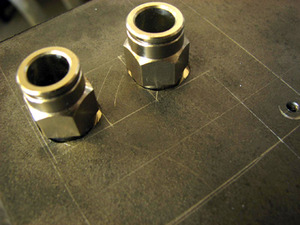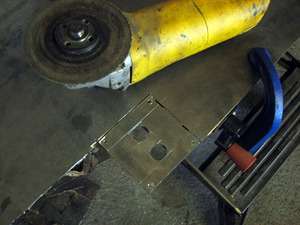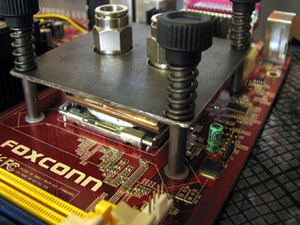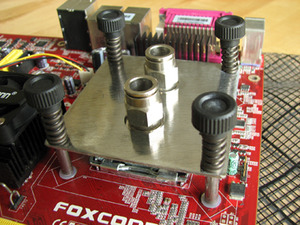
Line it up
Next you need to take the dimensions of your waterblock. If it’s not a simple rectangular shape this can be very tricky. What’s most important is that the center of the water-block is lined up centrally in the clamping plate. For a regular shape the best way to do this is to measure the block and then scribe the dimensions onto the plate. More complex shapes will require that you place the block down and trace around it. This gives you an idea of how the block will sit under the clamping plate.The final measurements you need to take are those of the inlet and outlet pipes, and any irregularities in the block’s surface, such as screw heads. This is the most important part of the process and where you’re going to have to use your ingenuity to design the clamp.
Machining the plate
Each block will require a different approach, but there should be similarities in each design. There needs to be as much of the clamping plate lying over the block as possible, i.e. aim to cut away as little material from the plate as you can. The plate must be symmetrical.If there is a cut-out on one side of the plate to allow a hose to pass through there must be a similar cut-out on the other side as this will balance the pressure across the plate. That said, if you’re using a very thick mounting plate – say 3mm or thicker – or you’re clamping a very wide block this is less important.
With all shapes marked you can start to cut out the material on the inside of the plate. Roughly cut out the required shape and then use a file to fine tune the profiles of the cut-outs.
Keep checking your cuts against the actual block you are going to mount. Remember to protect the bottom of the block from being scratched on your work surfaces though.
Left: As you file away the waste metal, continually check the fit. You don't want to file away too much; Right: One you're satisfied that the clamp is correct, cut it from the plate
Pay particular attention to getting the block situated centrally under the plate, and leaving as much material lying across the top of the block as you possibly can. When you are satisfied with the fit cut along the outline of the place and remove the finished piece from the sheet.
If you like you can polish the steel with some sandpaper or a flap disk and then spray it with a clear lacquer. Then all you need to do is install it in your computer and carefully clamp it down, taking great care that the block remains in the centre of the clamp until pressure has been properly and evenly applied.
If you were careful with your measurements and cutting, the clamp should line up with the motherboard's mounting holes and the waterblock precisely

MSI MPG Velox 100R Chassis Review
October 14 2021 | 15:04












Want to comment? Please log in.